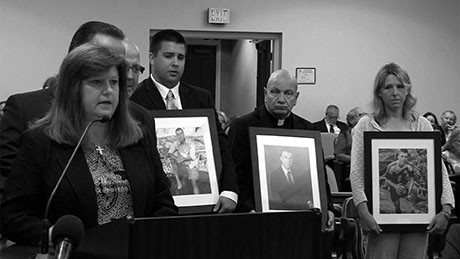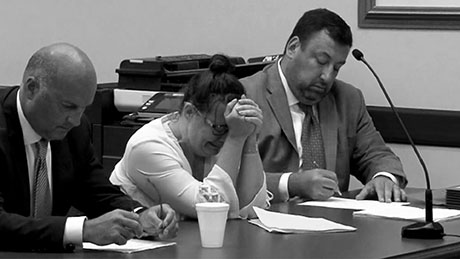Serrano gets the max allowed by law for killing aspiring teen doctor last summer

The 49-year-old mother of three who drove drunk a year ago and killed a Hinckley teenager, leaving him to die alone in ditch in a cornfield off Sumner Road, was given the maximum possible sentence today in Genesee County Court.
Jennifer Serrano was convicted by a jury on July 2 of second-degree vehicular manslaughter, leaving the scene of an accident, and misdemeanor driving while intoxicated. Connor Lynskey was killed sometime after midnight on Aug. 11 on Sumner Road while walking back to a campsite after attending a country music concert at Darien Lake Performing Arts Center with friends.
But before she was sentenced, Serrano had to listen to the tragedy she has wrought on Connor's family and hear firsthand of his mother's heartbreak.
Donna Lynskey read her remarks at the podium in a packed courtroom, with her husband, Michael, gently holding her right elbow, and Connor's brother, other relatives and their priest holding large portraits of Connor -- in his soccer uniform, suited in a senior high school photo, smiling in khaki shorts and a light-colored shirt.
A Mother Tells A Courtroom About Her Son
"I want you to know who Connor was," she said.
By last summer, the 18-year-old had completed his freshman year with honors at Siena College in Loudonville and he planned to become a rural doctor. At the time of his death, he had one week left of his summer vacation before he was scheduled to return Aug. 19 for his sophomore year and training as a resident assistant in the freshman dorms.
He had already been accepted into Upstate Medical University’s Medical Doctor Program during his senior year at Holland Patent High School, where he had a 95.35 GPA and was the president of his class.
Connor was also captain of his soccer team, named to the Center State Conference All-Star Team for soccer, and was the Division 1 Player of the Year in 2017 for the Center State Conference.
In his honor, Connor’s soccer coach now gives out the Connor Lynskey Award to a player on the Holland Patent Varsity Soccer Team at the end of the season. The award reads that it goes to “someone who always gives 100 percent at everything he does; doesn’t take shortcuts; always leads by example; is kind; a leader off and on the field; a good musician; does great in school; is an excellent runner; and always treats people with respect."
Connor also participated in track and field in high school, was a talented saxophone player, both in his high school wind ensemble and jazz band. His classmates voted Connor as the most likely to succeed in his graduating class.
"Not once was there ever a phone call home from school that Connor had misbehaved," Donna Lynskey said. "At all parent-teacher conferences and open houses, the comments that were made about Connor were glowing – respectful, kind, intelligent, and the list goes on."
He also enjoyed kayaking, skiing, swimming, pickup games of football and soccer, climbing the Adirondack Mountains, and February breaks in Myrtle Beach, S.C.
He was employed at his family's restaurant where he started as a landscaper and dish washer and then moved up to carver, cook and banquet server. He took pride in working with his father and helping out his family.
On several occasions Connor talked about wanting to be a foster parent when he got older. He wanted to help kids who were less fortunate. He always came home inspired whenever he volunteered at the soup kitchen in Utica, his mother said.
"He stated to our priest that he enjoyed being an altar server because that is when he felt closest to God," Lynskey said.
Connor’s favorite place to go was Ager Falls (in Lyons Falls) to swim, discover, explore and slide down the rocks.
"We are grateful that the Sunday before Connor was killed we went there as a family one last time and took some priceless photos of him," she said.
In fact, 2018 was the best summer of his life. He had grown into an impressive young man. He had spent a week on Montauk Point with his cousin, aunt and uncle. He ran the 15K Boilermaker Road Race in Utica with his cousins and uncle. And he traveled to Lima and Machu Picchu, Peru, where he spent close to three weeks learning the culture with newfound Peruvian friend, Manu, from Siena College. Connor had already made plans to travel to Peru again in 2019.
"Above all Connor was a kind and caring person," his mother said. "Connor was the one to find time to travel to his grandmother’s house just to check in on her and play a game of rummy or seeing what he could do to help her around the house.
"He was the one to take time out of his busy schedule to hand write his grandmother letters via snail mail (USPS) to let her know how he’s doing at college since she doesn’t email or text."
The aspiring doctor was also full of joy.
"When you were around him you couldn’t help but feel his happiness and his love for life," his mother said. "He wasn’t loud and boisterous. He was a listener, a thinker. He had his grandfather’s steel blue eyes and his father’s wonderful sense of humor. ... He was the mysterious light that others followed. We all relied on him."
His biology study group at college said they could count on Connor to liven things up when they were stressing out because he'd tell a silly joke like "Under what?" to try and get someone to say "Under where?" even though they'd heard the gag a hundred times.
"He had a way about him that brought happiness, peace and inclusiveness," Lynskey said. "Connor seemed to have a deeper understanding about life than most people."
A Miracle Child
After their first child, Michael Jr., was born the doctor told the Lynskeys they would not have any more children. But nearly six years later Connor was born.
And his big brother Michael took great pride in teaching his little sibling things he needed to know.
"Connor was Michael’s protégé," she said. "They played sports, video games, fantasy football, and the game of life. They were best friends. When they were together, it was as if they had their own language that only they understood."
Connor's medical school ambitions were modeled after his brother's, who had blazed the trail to medical school before him. They planned to open their future medical practice together in Upstate New York.
Almost three years after Connor’s birth, his sister, Meghan, was born.
"Connor will always be her guardian angel," his mother said. "From the time Meghan was born, Connor took his role as big brother seriously and guided her every step of the way."
Their Lives Are Shattered
Connor was killed sometime after midnight on Aug. 11 last year. They received a phone call about 9 a.m. that morning that Connor was missing.
“Missing? What do you mean? He went camping with his friends. How could he possibly be missing?” she told the caller.
His parents quickly left on the three-hour trip to Darien Lake, praying the whole way there was some misunderstanding. It just didn’t make sense to them that their responsible, reliable son was missing. They called the area’s hospitals and they prayed. By 11 a.m. “we were at a loss. We knew something was terribly wrong.”
As they crossed Sumner Road, they noticed the road was closed and a police car had its lights flashing. As they came closer, they noticed several police cars at the side of the road with their lights on. “This couldn’t be.” Then an officer approached their vehicle and told them they could proceed no further.
I explained “My son is missing. Did you find my son?”
Lynskey paused at this point and swallowed hard, fighting back tears.
She told the officer her son’s name and the officer said yes, they had found her son. "Can we see him?" she asked. “He stated ‘no you cannot.’ “
“Is he dead?” she asked, “and he shook his head yes. 'Are you sure? Are you sure he is dead?' And the officer replied ‘I am sure.’ "
“That’s when our lives were shattered. Unless you have experienced the loss of one of your children, you cannot understand or even begin to imagine the anguish. Our world fell apart. The shock was overwhelming. To think that Connor had worked so hard for his short 18 years … and it was taken away so quickly. All of his hopes and dreams were extinguished. He would never be able to help the people of Upstate New York that he so wanted to."
They tried to fathom how someone could hit him and leave him in a ditch to die.
"At first we thought it must have been a young driver – someone under age 25 whose brain hadn’t fully developed yet, somebody who did not realize the extent of their actions," she said.
But after they came to learn the killer was a then-48-year-old mother of three, with a passenger in the car – another mother, she said they "lost their faith in humanity."
Things Have Different Meanings Now
Everything in their lives has changed – "from the meaning of songs on the radio, to the patterns of the clouds in the sky, the actions of the birds around us, the meaning of the butterflies flying near us, to the pain of waking up in the morning and realizing it isn’t just a nightmare. This is our reality.
"Little by little, we are trying to rebuild our lives. It's a slow process. I'm told by others who’ve lost children that the pain never subsides. All you can do is learn to live with the pain and try to put the shattered pieces back together. We cannot get through it; but we are trying to live forward.”
The Way It Appears
"According to court testimony, it appears it wasn’t enough for the defendant to consume 22 to 29 alcoholic beverages on Aug. 10 into the early morning hours of Aug. 11," Connor's mother said. "She then decided to get behind the wheel of a motor vehicle, turning it into a deadly weapon. It appears that it wasn’t enough for her to decide to leave my son in the ditch on Sumner Road to die alone.
"It appears that if she had stopped and called 9-1-1 my son would have had a chance at survival. It appears that didn’t matter to her or the passenger in that vehicle. The only concern they had was for themselves.
"Even after nearly hitting a police vehicle and watching the body cam video of the field sobriety test, I was perplexed and disgusted. How could a person who just hit a human being and left him at the side of the road be laughing and smiling? And even after all that the defendant has shown no remorse and took these charges to trial."
Lynskey then quoted from a transcript of a phone call that Serrano had with someone named "Dennis" while in Niagara County Jail: “I know that I did the stupidest thing I could have possibly ever done. But I’ve done stupider and this is a horrible accident.”
Connor's mother finds it "absolutely despicable" that Serrano chose to drive drunk, killed her son, left him in a ditch to die, then took the case to trial and tried to blame Connor for his own death.
"She has no regard for human life except her own," she said.
She then asked Judge Charles Zambito for the maximum sentence allowable by law: four-and-two-thirds to 14 years in state prison.
Throughout the mother's statement, Serrano seemed to pay attention and she looked at Lynskey as she spoke. Serrano wore heavy bangs and had her hair in a topknot pinned unneatly on her head. She had on eyeglasses, wore dark slacks and an ivory blouse. She was flanked by her two attorneys. She did not cry -- at first.
No Plea Deal Ever Considered
District Attorney Lawrence Friedman spoke next and said this case is the first time in his nearly 38 years of working as a prosecutor that he made absolutely no plea offer.
The reason is because when he spoke to Connor's mother initially about the case and told her that the maximum this defendant was facing was four-and-two-thirds to 14 years, she couldn’t comprehend how that could be possible.
"I had to agree with her," Friedman said. "That sentence is woefully inadequate."
But it's possible because of the way the statute is written and by Serrano's decision, some say a calculated one, to refuse a Breathalyzer test, not report the accident and therefore not be subjected to BAC mandatory testing.
Based on testimony at trial, had her BAC been known, Friedman, Lynskey and subsequently Judge Zambito all said they had no doubt it would have been above .18 percent – which would make the crime a first-degree vehicular manslaughter charge – a Class C felony – with a sentence of five to 15 years. If you add the two-and-one-third to seven years for leaving the scene of an accident, she could have faced seven to 22 years.
"Concurrent sentencing would constitute a horrible failure to recognize what the defendant did by fleeing the scene," Friedman told Zambito.
The district attorney reminded the court that the defendant ignored pleas from her own passenger about striking something in the roadway and drove off. When she nearly struck a deputy's vehicle a short time later, she refused a BAC test.
"She knew what she had done," Friedman said. "She knew this was not just a minor DWI."
After she was arrested for DWI and her license was taken, she still got into her Jeep Wrangler and drove on the Thruway to her home in Chautauqua County, Friedman said. Ultimately it was her passenger's husband who reported the accident, the DA said, and the passenger contacted an attorney who then called Genesee County Sheriff's Office to check on a hit-and-run accident.
Friedman said he read the letters submitted to the court by Serrano's friends and family, but the person described is not a person capable of committing the acts in this court case.
"That person is not someone who simply engaged in an uncharacteristic lapse of judgment -- her decisions, her choices, her actions showed over and over a callous disregard for human life -- of others, not just Connor’s," Friedman said. "She continued to drive while intoxicated after striking Connor, causing his death, after her license was suspended, while she was still under the influence of alcohol."
This point prompted Serrano to twist uncomfortably in her chair, slump over the table and sob.
"Then she tried to convince a jury that Connor was responsible for his death, which a unanimous jury did not buy beyond a reasonable doubt," Friedman said.
He then read more quotes from transcripts of her jailhouse phone calls: "I feel so guilty, I feel so bad for that mother." In an effort to blame her passenger she says “the princess couldn’t walk two miles to the tent. …. I’m just pissed, you know, I take my blame in it. I shouldn’t have driven. But you know what Babs? We had a tent pitched at Brook’s house on 77, two miles up the road and the bitch didn’t want to walk. The princess didn’t want to walk. … I am responsible for my own choices. ... I deserve everything I get."
"Truer words were never spoken, your honor, she deserves everything she gets," Friedman added.
'She Knows She Is Really Messed Up'
Her attorney Frank LoTempio said it's been "a tough road for everyone involved." He perfunctorily apologized to the Lynskey family for their loss.
Then he told Judge Zambito that the person who has been portrayed in the Genesee County courtroom is not the person Serrano really is. He characterized her as remorseful and said "she knows she is really messed up" -- a fact underscored by her attempted suicide a few days after the incident.
"She never had an issue with the law before," LoTempio said. "She's not a monster as Mr. Friedman portrayed her to be. ... This is a successful businesswoman who was strained by going through a difficult divorce. She will make a difference when she gets out. She's a very, very, very good person.”
LoTempio said a consecutive sentence, versus a concurrent one, is “not at all” appropriate in his client's case. He even cited a case from January where Zambito sentenced someone involved in a serious injury accident while intoxicated to six months in prison and five years probation. This is the kind of balance Zambito should consider today, he added hopefully, and noted that his client has already been behind bars for a year to date.
But Zambito was unpersuaded after reviewing all of the case materials and the letters from family and friends on both sides. He acknowleged that he had wide latitude in sentencing.
"Connor Lynskey appeared to be an outstanding young man with a bright and luminous future," Zambito said. "His death amounts to an immeasurable loss to his family, his friends and the community. Who’s to say whose lives he might have touched had he been able to live."
Nonetheless it is "untenable" to weigh the value of someone’s life in reaching a sentence. All life is valuable. He acknowleged the defendant has no prior criminal history.
For the Judge, the Facts Speak for Themselves
"The most important factors are the facts of the case itself," the judge said.
He agrees with the prosecution that the defendant was highly, highly intoxicated. She was driving the vehicle that struck and killed Connor Lynskey.
"As to the question of Connor walking in the roadway, with all respect to the jury, it doesn’t matter," Zambito said.
Serrano drove with an open container of alcohol in the vehicle. Her passenger said when they were stopped on Route 77, she either fell asleep or passed out.
Testimony of the defense expert did not indicate she did not see Connor; she should have known she hit something. She should have seen him. The front right fender was torn off, flew over vehicle, the windshield smashed, the passenger side mirror was broken off.
Later, she tried to talk her way out of getting arrested by Deputy Henning, Zambito said, citing her ties to law enforcement. When that was not successful, she became verbally combative. She refused testing and did not report an accident, which allowed her to avoid mandatory testing, therefore her degree of intoxication is unknowable.
Then she still drove after her license was revoked that night following the near-accident with the deputy. She didn’t go to the police, she talked to an attorney. Her friend finally reported it.
"Her actions are so egregious, they outweigh mitigating factors," Zambito concluded.
He was singularly unimpressed with the letter she wrote on her own behalf to him.
"Your statements are so nuanced, to express regret without admitting guilt, maybe it was written by your attorney," Zambito said.
She mentions having "no intent" – none is required, he noted, and "to say you expected to be found not guilty, tells me you still don't feel guilty."
Indeed, she writes as if she's being wrongly persecuted – that she’s been treated unfairly by the DA, law enforcement. The overall correspondence lacks sincerity, he told her.
"I do try to be balanced, I'm not what anybody would call a hanging judge, but I can’t find any reason not to give the maximum possible," Zambito said.
So he wrapped matters up by declaring she will serve two-and-one-third to seven years indeterminately on the conviction of second-degree vehicular manslaughter and the same amount of time consecutively for leaving the scene of an accident -- a total of four-and-two-thirds to 14 years, along with a $2,000 fine.
Serrano studied her hands and picked at her nails as the minutae was read.
Upon release, her NYS driver's license will be revoked for one year for the manslaughter conviction. For the misdemeanor DWI, her prison sentence is one year to run concurrently, with a $500 fine and a license revocation of six months.
For aggravated unlicensed operation in the second degree, she'll serve 180 days concurrently and pay a $500 fine.
Post-release conditional discharge was set for three years and she must have an interlock ignition device on her vehicle once she receives her driving privileges back.
She'll also pay: a $50 DNA fee; $75 surcharge on misdemeanor DWI conviction; a Crime Victim Assistance Fee of $25; $195 DWI and vehicle and traffic law surcharge.
All fines must begin being paid within 60 days of release at the rate of $100 a month.
Serrano did not look back at anyone in the gallery as she was led out of a courtroom side door to begin serving her sentence.
'Connor's Way' -- 'Something Good'
Also, Connor's mother announced the creation of "Connor's Way" -- "to help something good come out of this" -- established by her son's friends and family members. It will offer "scholarship opportunities to graduating high school seniors and to future medical students who want to work in underserved communities, and also help families in need."
Photos: Still frames taken from video by Alecia Kaus/Video News Service.
Story based on video and audio provided by Alecia Kaus/Video News Service.




